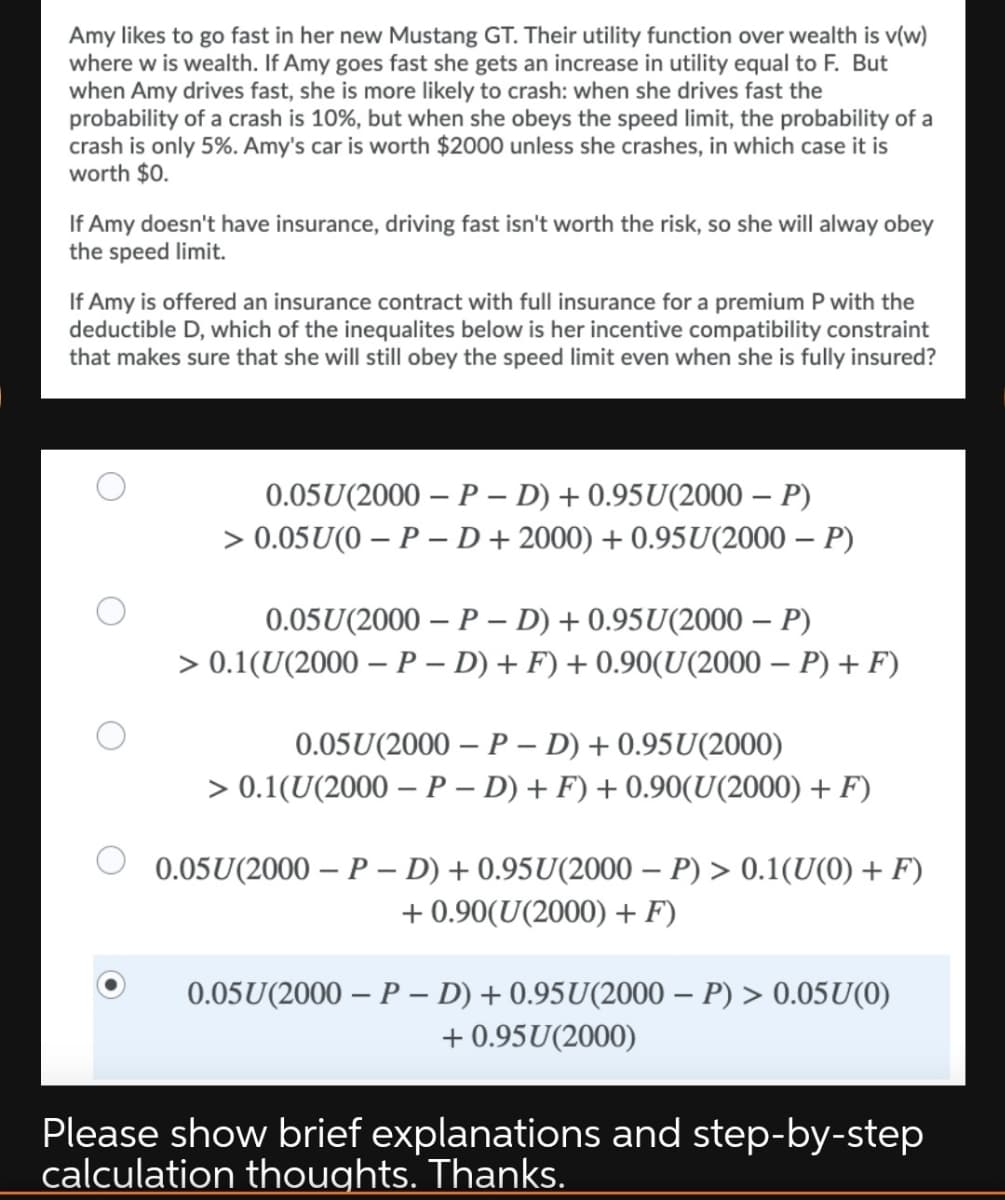Amy likes to go fast in her new Mustang GT. Their utility function over wealth is v(w) where w is wealth. If Amy goes fast she gets an increase in utility equal to F. But when Amy drives fast, she is more likely to crash: when she drives fast the probability of a crash is 10%, but when she obeys the speed limit, the probability of a crash is only 5%. Amy's car is worth $2000 unless she crashes, in which case it is worth $0. If Amy doesn't have insurance, driving fast isn't worth the risk, so she will alway obey the speed limit. If Amy is offered an insurance contract with full insurance for a premium P with the deductible D, which of the inequalites below is her incentive compatibility constraint that makes sure that she will still obey the speed limit even when she is fully insured?
Amy likes to go fast in her new Mustang GT. Their utility function over wealth is v(w) where w is wealth. If Amy goes fast she gets an increase in utility equal to F. But when Amy drives fast, she is more likely to crash: when she drives fast the probability of a crash is 10%, but when she obeys the speed limit, the probability of a crash is only 5%. Amy's car is worth $2000 unless she crashes, in which case it is worth $0. If Amy doesn't have insurance, driving fast isn't worth the risk, so she will alway obey the speed limit. If Amy is offered an insurance contract with full insurance for a premium P with the deductible D, which of the inequalites below is her incentive compatibility constraint that makes sure that she will still obey the speed limit even when she is fully insured?
Chapter7: Uncertainty
Section: Chapter Questions
Problem 7.5P
Related questions
Question

Transcribed Image Text:Amy likes to go fast in her new Mustang GT. Their utility function over wealth is v(w)
where w is wealth. If Amy goes fast she gets an increase in utility equal to F. But
when Amy drives fast, she is more likely to crash: when she drives fast the
probability of a crash is 10%, but when she obeys the speed limit, the probability of a
crash is only 5%. Amy's car is worth $2000 unless she crashes, in which case it is
worth $0.
If Amy doesn't have insurance, driving fast isn't worth the risk, so she will alway obey
the speed limit.
If Amy is offered an insurance contract with full insurance for a premium P with the
deductible D, which of the inequalites below is her incentive compatibility constraint
that makes sure that she will still obey the speed limit even when she is fully insured?
0.05U(2000 – P – D) + 0.95U(2000 – P)
> 0.05U(0 – P – D + 2000) + 0.95U(2000 – P)
0.05U(2000 – P – D) + 0.95U(2000 – P)
> 0.1(U(2000 – P – D) + F) + 0.90(U(2000 – P) + F)
0.05U(2000 – P – D) + 0.95U(2000)
> 0.1(U(2000 – P – D) + F) + 0.90(U(2000) + F)
0.05U(2000 – P – D) + 0.95U(2000 – P) > 0.1(U(0) + F)
+ 0.90(U(2000) + F)
0.05U(2000 – P – D) + 0.95U(2000 – P) > 0.05U(0)
+ 0.95U(2000)
Please show brief explanations and step-by-step
calculation thoughts. Thanks.
Expert Solution
This question has been solved!
Explore an expertly crafted, step-by-step solution for a thorough understanding of key concepts.
This is a popular solution!
Trending now
This is a popular solution!
Step by step
Solved in 2 steps

Knowledge Booster
Learn more about
Need a deep-dive on the concept behind this application? Look no further. Learn more about this topic, economics and related others by exploring similar questions and additional content below.Recommended textbooks for you


Managerial Economics: A Problem Solving Approach
Economics
ISBN:
9781337106665
Author:
Luke M. Froeb, Brian T. McCann, Michael R. Ward, Mike Shor
Publisher:
Cengage Learning


Managerial Economics: A Problem Solving Approach
Economics
ISBN:
9781337106665
Author:
Luke M. Froeb, Brian T. McCann, Michael R. Ward, Mike Shor
Publisher:
Cengage Learning